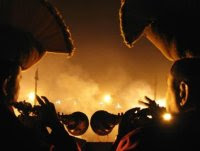Agam's Gecko


Tuesday, January 13, 2009
LANTERNS: THE WINDBLOWN AND THE EXTINGUISHED
| A |
festival of lights is something that many cultures have in common. Indians have Diwali, the Thais have Loy Krathong (with water-borne and air-borne lanterns), the Chinese have their annual Lantern Festival, and I'm sure there are many more. Lighting displays have also been an important aspect for Christmas observers around the world.
Tibetans also have their festival of lights, called Ganden Ngam Cho, a memorial day which commemorates the death of the 14th century Buddhist figure Je Tsongkhapa and is marked by the lighting of lamps and bonfires.
There have been some changes to the Tibetan festivals over recent years, owing to the petulant Chinese discomfort with any display of Tibetan identity.
 Ganden Ngam Cho Festival 2005 Photo: WoeserLhasa |
"Losar, Saka Dawa, Shoton, Ganden Ngam Cho...
Originally they were for honoring the Buddha, pleasing the deities, driving out demons, and having fun."
 Ganden Ngam Cho Festival 2005 Photo: WoeserLhasa |
"This phantasmagorical consolation
Was enough: one could ignore the cops and plainclothesmen standing near."
 Ganden Ngam Cho Festival 2005 Photo: WoeserLhasa |
"Heedless of the ban, the Tibetans gathered from all directions.
I watched flames soar into the sky
And light the masked faces."
 Ganden Ngam Cho Festival 2008 Photo: Xinhua via WoeserLhasa |
The words above are fragments of a poem by the Tibetan writer Woeser, "2005-2008: Nothing left but a windblown flame," translated by her publisher A. E. Clark (with notes from both poet and translator). The thumbnails are linked to her blog article, where the full images may be viewed (or view the machine translation page for the photo captions). But please read the full poem at Ragged Banner Press -- I didn't want to take more than a few lines, with which to tempt you."Went to the Barkor this afternoon.
A slew of shops had closed early.
But you could hear loudspeakers blaring over and over, in Tibetan and Chinese,"TO TAKE PART IS PROHIBITED.
TO BE A SPECTATOR IS PROHIBITED.
TO GATHER A CROWD IS PROHIBITED.
All but the last photo are also Woeser's, but take a close look at the last two. They were taken from the exact same spot in Lhasa, three years apart. In 2008, the Tibetans' night of lights was a rather dark and paranoid affair -- no festive lanterns or bonfires were permitted. The quoted "this afternoon" refers to December 21, 2008 (the other quotes refer to the pictured 2005 festival).
China is turning out the lights on Tibetan culture in the occupied land, both figuratively and literally.
| L |
ives have also been quietly extinguished, behind closed cell doors. The deaths in custody, of a number of Tibetans who were detained for speaking their conscience, were noted here at the end of last month. Reports in the new year now indicate that China is beginning to release people they consider likely to die from their injuries, received from the torture and beatings administered under detention.
A Tibetan student in India, Tenzin Choeying, sums up the policy this way: "They (China) are turning Tibetan prisoners into live corpses, and handing them over to the families to avoid being blamed for their deaths."
Guru Dorji, from Kardze Prefecture, was brutalized in prison (it's not reported when he was arrested, or the circumstances). The Voice of Tibet radio service (Tibetan language news, based in Oslo), citing reliable sources, reported that people from Guru's hometown were summoned to pick him up on January 1. He was in such a seriously feeble condition, he was unable to eat anything without vomiting. In anticipation of his own death, Guru has bequeathed his property to his two children and asked his neighbours to take care of them. Their mother had died while Guru was in prison.
In another incident, a girl name Rigden Lhamo, 21, from Kardze was handed over to her family around December 25, 2008, as authorities feared she might succumb to her injuries in prison. She was seriously injured during the protests on May 28, 2008 and was later imprisoned.On June 1, 2008 I reported here on the May 28 incident, in which nuns of Drakkar Nunnery of Kardze County mounted a peaceful demonstration at the town's market:
In the May 28 incident, Ven. Sangye Lhamo, 26, Ven. Tsewang Kando, 38, and Ven. Yeshi Lhadon, 24, were apprehended and taken to an unknown location in an unknown condition. All are from Kardze County. About an hour afterwards, a solo protest was mounted by Rigden Lhamo, 21, a female student of the Tapontsang family (some readers may know of Ama Adhe Tapontsang, the Voice that Remembers). Rigden Lhamo unfurled the Tibetan national flag and shouted freedom slogans at the Kardze County government headquarters.Later that month it was confirmed that she had indeed been shot.
Gunshots rang out, according to witnesses. There is no clear information as to who the security forces were shooting at, or who they might have hit. Rigden Lhamo was taken away and witnesses saw blood on her body, but it can't be determined whether this was from the shooting or from the severe beating she also suffered. It is confirmed that she was injured in some manner and should have had medical attention. It is not known if she received any, nor where she is being held.
On May 28, a 21-year old Tibetan student, Rinchen (or Rigden) Lhamo, was shot in the leg after she called for the return of the Dalai Lama to Tibet and the release of Tibetan prisoners outside the Kardze county government headquarters.Back to the current reports now, and two other nuns from Kardze were discharged ahead of their scheduled release date. Rinchen and Jampa Dolma of Getsul Nunnery were arrested on May 22 along with other protesting nuns. The two were released on December 22 for unknown reasons.
Nun Dolma Yangtso from Laru Nunnery in Serthar County (Kardze Prefecture) was wounded by Chinese security forces on August 10, 2008, during a peaceful protest. Her family has been informed that she is sentenced to 2 years in prison. The incident was reported here on August 23.
On August 10, Buddhist nun Dolma Yangtso, 34, made a peaceful demonstration in Kardze with the freedom slogans, "Tibet belongs to Tibetans," "Release all Tibetan political prisoners including Panchen Lama" and "The Chinese Government did not keep the promise it made at the time of winning the Olympic bid." Security forces struck her with their driven vehicle, and then began beating her. Dolma is apparently made of tougher stuff, as she continued shouting words of freedom. She was rendered unconscious after being shot with some sort of weapon, and then arrested.As incredible as it may seem, displays of such courage have continued in Kardze into the new year, Radio Free Asia reports.
"On Jan. 5, a Tibetan man protested in front of police headquarters in downtown Kardze [in Chinese, Ganzi] at around 12 p.m.," said a local Tibetan woman, who asked not to be named.The man was Ngawang Sonam, about 32 years old, hailing from Horpo village of Tsonggo Township, in Kardze County. He was previously detained in 2000 for protesting Chinese rule, and has two children.
"He shouted slogans calling for the independence of Tibet and threw several thousand paper fliers into the air. The fliers included prayer flags and protest leaflets."
"After he had protested for about three minutes, police and Public Security Bureau officials fired a tranquilizer gun at him, severely beat him, and took him away in a police vehicle," she said.Searches and surveillance of Tibetans have been increased in Kardze since Ngawang Sonam's protest a week ago. Two weeks ago, a Tibetan woman had protested in the same location, according to another witness.
"On Dec. 29, a Tibetan woman named Konchok, age 29, went to the public square in front of the Kardze police headquarters. She shouted slogans for several minutes calling for Tibetan freedom and for the long life of His Holiness the Dalai Lama."Military and police vehicles rushed to the scene and, according to the witness, fired weapons at her. It was not known what type of rounds were used. The witness continues,
"She also tossed flyers in the air," the source said.
"No one knows whether she was hit, but she was dragged into a vehicle and taken away. Even then, she continued to shout, calling for the long life of the Dalai Lama."Konchok is from Kudu village of Kara Township, in Kardze County.
RFA contacted the Kardze Public Security Bureau for comment, but the official refused to confirm or deny any of the protests or detentions. However, it seems that the first protester of 2009 has achieved some notoriety in Kardze. When the reporter mentioned him by name, the official exclaimed, "Oh, Ngawang Sonam!" and immediately hung up the phone.
Don't forget to read that poem.
.











 Our way of saying "thanks" in the Thai way. Here a nak muay Thai (kickboxer) offers respect and thanks for his teacher (wai khru) before a match. This is our local variation on the ubiquitous "hat tip" used in general blog culture.
Our way of saying "thanks" in the Thai way. Here a nak muay Thai (kickboxer) offers respect and thanks for his teacher (wai khru) before a match. This is our local variation on the ubiquitous "hat tip" used in general blog culture.




